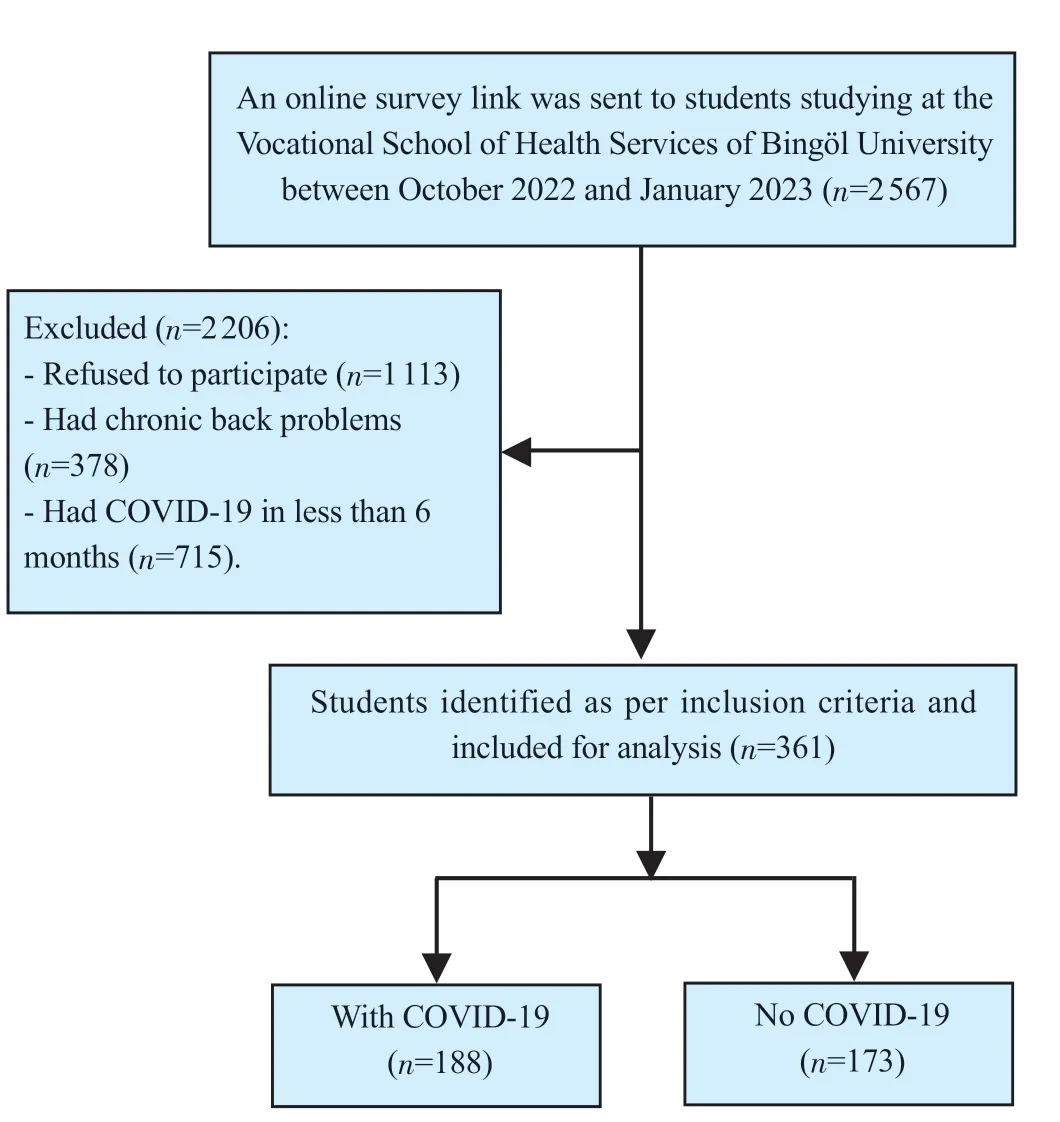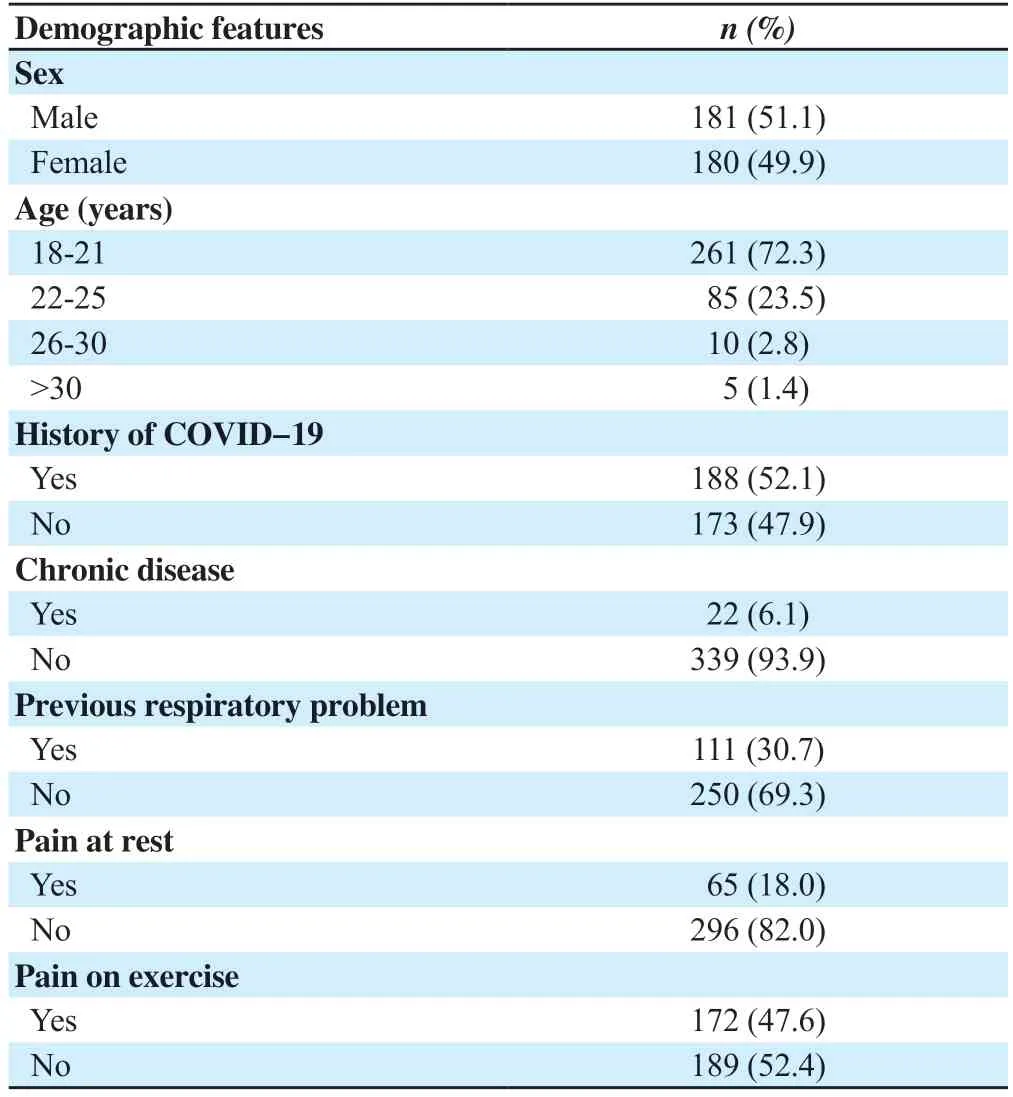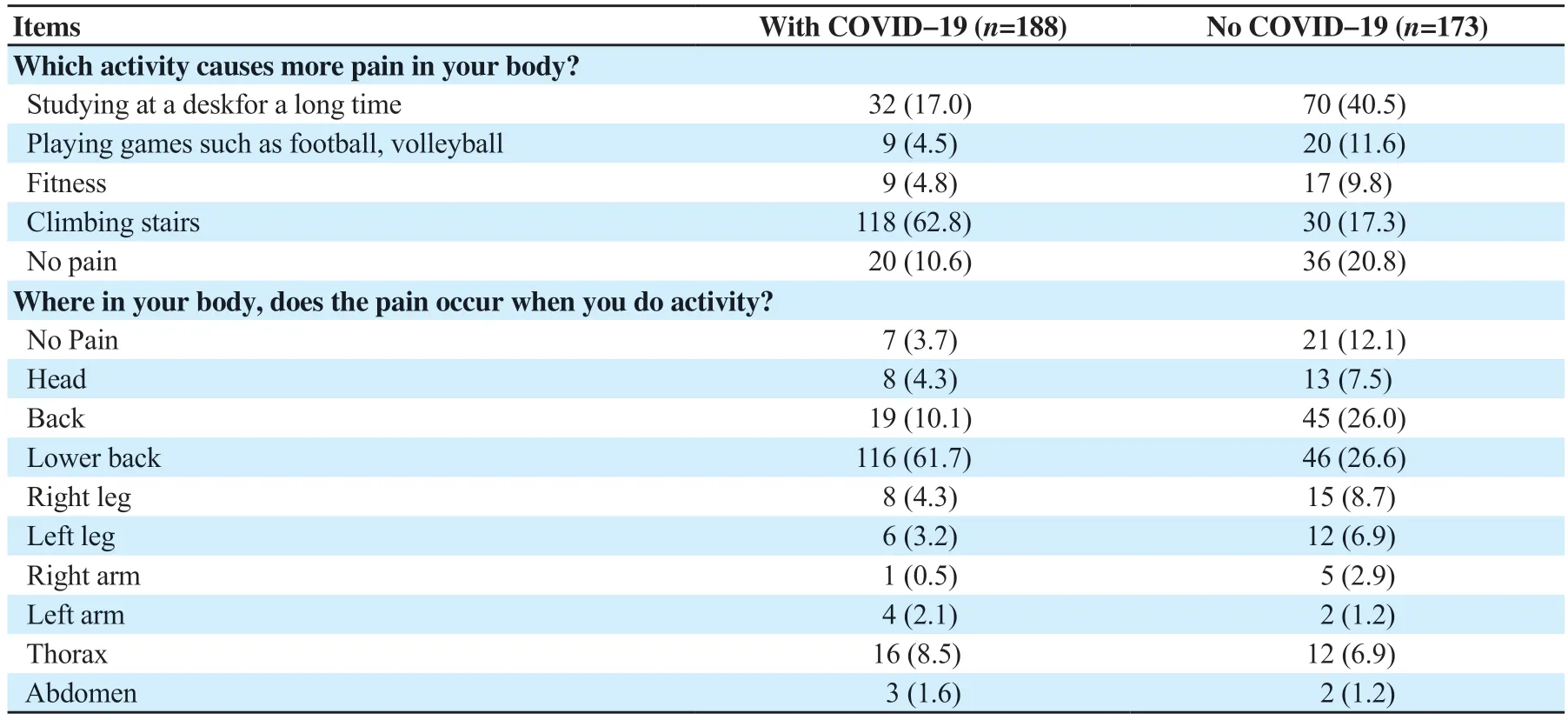Effects of long COVID-19 among young adults in Turkey: A crosssectional study
Mehmet Kaplan,Mesut Çelik,Muhammed Yusuf Özer
Vocational School of Health Services,Bingöl University,Bingöl,Turkey
ABSTRACT Objective: To investigate the cognitive state,psychological problems such as depression and anxiety,and pain in the musculoskeletal system among young adults with post-COVID-19 (long COVID) syndrome.Methods: This descriptive study included 361 students studying at the Vocational School of Health Services of Bingöl University in Turkey.Data were collected using the Socio-Demographic Information form,the Beck’s Depression Inventory,the Cognitive Appraisal Scale,and the Visual Analogue Scale for pain.Results: Compared to those without COVID-19,the mean depression score,cognitive appraisal score,and mean Visual Analogue Scale score of the young adults with COVID-19 were significantly higher.There was no significant difference in pain assessment at rest between those with COVID-19 and those without COVID-19.Conclusions:Young adults with COVID-19 are more depressed,their cognitive functions are more easily negatively affected,and experience more pain during exercise.
KEYWORDS: Long COVID;Young adults;Cognitive appraisal;Depression;Pain
1.Introduction
As a significant public health crisis in the 21st century,COVID-19 has escalated into a pandemic,causing millions of deaths around the world.Today,although the devastating impact of the COVID-19 pandemic has decreased,symptoms of the disease continuously affect the life and health of those who have had COVID-19,leaving permanent effects in some individuals.This condition is called post-COVID or long COVID syndrome[1-3].This syndrome is a serious condition that negatively affects patients’ social life as well as quality of life and causes severe problems such as depression,fatigue,shortness of breath,pain in the musculoskeletal system,and impaired cognitive functions[1-4].Some studies found that post-COVID syndrome occurs in individuals as early as two months after recovery from COVID-19 and could persist with symptoms for months,while some studies report that the symptoms begin to show at the sixth month of recovery and may involve variations[5].
COVID-19 causes many negative effects on individuals as it affects all body systems.It is reported that cognitive functions are negatively affected by COVID-19[6,7].This situation is of particular importance for young adults,who are more active than other age groups.Among young adults,in addition to the impact on cognitive functions,the emergence of depression,which is related to the chemical balances in the brain,may lead to decreased quality of life or unemployment/loss of labor force[8].Additionally,it has been observed that pain in the nervous and musculoskeletal systems causes insomnia,limitations in daily activities,loss of work,and negative effects on social life[9].
The present study aims to investigate the changes in cognitive status,psychological problems such as depression and anxiety,and pain in the musculoskeletal system among young adults with COVID-19.
2.Patients and methods
2.1.Study setting and design
The study was descriptive and conducted with students attending the Vocational School of Health Services of Bingöl University between October 2022 and January 2023.
2.2.Ethical approval
Ethics approval was obtained from the Directorate of the Vocational School of Health Services.The rules specified in the Declaration of Helsinki were adhered throughout the study.Verbal consent was obtained from the individuals.
2.3.Inclusion and exclusion criteria
Students who (1) volunteered to participate in the study,(2) were 18 years of age or older,(3) did not have chronic back problems,(4) did not have hearing or vision problems that prevented participation in the study,and (5) had COVID-19 at least 6 months prior or never had COVID-19 were included in the study.
Students who did not volunteer to participate in the study were not included.
2.4.Research tools
The Socio-Demographic Information form prepared by the researchers,the Beck’s Depression Inventory (BDI),the Cognitive Appraisal Scale (CAS),and the Visual Analogue Scale (VAS) for pain were used to collect the data.
In the Socio-Demographic Information form created by the researchers,age,sex,COVID status,chronic disease status,and presence of previous respiratory system disease were questioned.
The BDI was developed by Becket al.for measuring the severity of physical and psychological symptoms in individuals[10].It consists of 21 self-reporting questions that emphasize emotional and cognitive symptoms while placing less emphasis on physical symptoms such as loss of appetite,weight loss,and decreased libido.Each question is evaluated with a number from 0 to 3 and the total score on the scale would be between 0 and 63.An increase in the total score indicates an increase in the depression level of the individual or his/her predisposition.The Cronbach’s alpha coefficient of the scale was stated as 0.92[10].Hisli-Sahin conducted a validity and reliability study for its Turkish version[11],and Cronbach’s alpha coefficient of the present study was found to be 0.89.
The CAS was developed by Lazarus and Folkman in 1984 aiming to determine the level of cognitive appraisal of stress among university students[12].The scale was adapted into Turkish by Terzi[13].The scale has a 5-point Likert structure and contains a total of 15 items,which can be divided into two subscales: the primary and secondary appraisal.The primary appraisal evaluates the meaning of a stressful situation to an individual,while the secondary appraisal evaluates the resources an individual has to deal with the stressful situation.The primary appraisal scale consists of 13 items.However,when the scale was adapted into Turkish,item 12 was removed as its factor load value was below 0.40.The options for the remaining 12 items are scored as: (0) not applicable at all,(1) somewhat applicable,(2) moderately applicable,(3) quite applicable,and (4) completely applicable.The secondary appraisal scale includes 2 items and the options for each statement in the scale is scored as (0) strongly disagree,(1) somewhat agree,(2) moderately agree,(3) strongly agree,and (4) completely agree.The scale is scored between 0 and 56.High scores are indicative of impairment in the cognitive state.The Cronbach’s alpha coefficient of the primary appraisal scale was found to be 0.90,and the Cronbach’s alpha coefficient of the secondary appraisal scale was found to be 0.87[13].In the present study,the Cronbach’s alpha coefficient of the primary appraisal scale was 0.94 and the Cronbach’s alpha coefficient of the secondary appraisal scale was 0.48.
The VAS for pain is a spectrum with 10 scales,ranging from “no pain” to “unbearable pain”.Level of pain can be expressed as the numbers on the scales along with descriptive words of pain.After critically reviewed ten studies,Begum and Hossain concluded that the visual analogue scale is a valid and reliable[14].
2.5.Data collection
An online survey link of Google form was sent to students studying at the Vocational School of Health Services of Bingöl University.Among the responses received,2 567 completed questionnaires were further reviewed,and in which 1 113 respondents did not agree to participate in the study,378 had chronic back problems,and 715 had COVID-19 less than 6 months.As a result,a total of 361 students who completed the survey,agreed to participate,and met the inclusion criteria,were included for analysis (Figure 1).

Figure 1.The study flowchart.
2.6.Statistical analysis
In the determination of the sample size,with α=0.05 and a confidence level of 95%,it was determined that the sample size is 357 students.
SPSS 22.0 package program was used for data analysis.Mean,number,percentage distributions,and standard deviation were used to display descriptive characteristics.The Cronbach α reliability coefficient was used to determine the internal consistency of the CAS and BDI scales.Since the data were normally distributed,the independent samplest-test was used for comparisons.In the present study,the analysis results were considered statistically significant at a confidence interval of 95% and a significance level ofP<0.05.
3.Results
A total of 361 volunteer students agreed to participate.Of the young adults,51.1% were male,72.3% were between the ages of 18-21 years old,52.1% had had COVID-19,93.9% had no chronic disease,30.7% experienced respiratory system problems before COVID-19,82.0% reported no pain at rest and 47.6% reported pain during exercise (Table 1).When asked about the activities during which they experienced more pain,62.8% of the participants with COVID-19 stated that they felt more pain while climbing stairs,while 40.5% of the participants without COVID-19 stated that they experienced more pain while studying at a desk for a long time (Table 2).Students with chronic lower back problems were not included in the present study.Among the young adults with COVID-19,lower back pain was the most common site of pain during any activity (61.7%),followed by back pain (10.1%).In the young adults without COVID-19,the most common site of pain during any activity was lower back pain (26.6%),followed by back pain (26.0%)(Table 2).

Table 1.Frequency analysis of demographic data (n=361).

Table 2.Pain-inducing activities and locations of pain according to history of COVID-19 (n,%).
The mean Beck’s depression score,CAS score,and the mean VAS score of those with COVID-19 were significantly higher than those without COVID-19 (P<0.01).There was no significant difference in the assessment of pain at rest between those with COVID-19 and those without COVID-19 (Table 3).

Table 3.Comparison of the mean Beck's Depression Inventory,Cognitive Appraisal Scale,and Visual Analogue Scale for pain scores.
4.Discussion
The present study shows that the effects of COVID-19,which has caused the deaths of millions of people and left permanent sequelae,are still ongoing and continue to cause anxiety,cognitive status impairment,and pain in some individuals.Long COVID is known to cause a decline in mental functions,and psychological problems such as depression,fatigue,and pain due to its effects on the nervous and musculoskeletal system[1-4].This is of great importance for young adults,who are more physically active and engage in more cognitive interactions compared to other age groups.
In the present study,according to BDI scores,it was determined that the young adults with COVID-19 were significantly more depressed than those without COVID-19.In addition to the interaction between COVID-19 and depression,previous studies have reported that there is a significant risk of psychiatric and neurological morbidity in the 6 months following COVID-19 infection,particularly in patients in severe states[15,16].Young adults are known to be the least affected by COVID-19[17].Even so,young adults are continuously being affected by COVID-19.Moreover,depression is considered one of the most common causes of disability in high-income countries.The persistence of depression in young adults,particularly when they make career choices or enter into the workforce,could reduce work productivity and loss of labor force and increase medical expenses[8].Another effect of long COVID is a decrease in cognitive functions.The present study shows that young adults with a history of COVID-19 experienced more cognitive dysfunction compared to those with no history of COVID-19.COVID-19 could cause decreased cognitive flexibility[6],memory problems[15],and mental fatigue[7].Some studies have even reported that it can cause delirium[18].The acute impact of COVID-19 on cognitive functions in the long term may lead to decreased academic success,decreased cognitive functioning,and impaired social skills in young adults.
No significant difference was found in threat-rest pain levels between young adults with COVID-19 and those without COVID-19.However,a significant difference was found in the pain during activity between young adults with COVID-19 and those without COVID-19.In the study,62.8% of the participants reported climbing stairs as the most painful activity,17.0% reported studying at a desk for a long time,and 10.6% reported that they experienced no pain.Among the participants with no history of COVID-19,40.4% stated that they felt more pain when studying at a desk for a long time,17.3% reported that they experienced more pain when climbing stairs,and 20.8% stated that they did not have any pain.COVID-19 is known to cause musculoskeletal pain[19].Pain during climbing stairs is due to the persistence of joint pain in long COVID.However,17.3% of the young adults who have not had COVID-19 stated that they felt pain while climbing stairs.The pain cannot be attributed entirely to COVID-19.
When asked about the body part where they experience the most pain during the most painful activity,61.7% of the participants with a history of COVID-19 responded with lower back pain and 10.1% with back pain.Among those who have not had COVID-19,26.59% reported lower back pain and 26.0% reported back pain.It is reported that 5.0% of patients with COVID-19 had lower back pain[20]and 6.0% in another study[16].It has been also reported that the cause of back pain may be due to stress,anxiety,and depression after COVID-19[9].The reason why the majority of the young adults with COVID-19 in the present study suffered from back pain may be due to multi-system inflammatory syndrome.It is thought that lower back pain in young adults occurs due to inflammation in different organs of the body.In addition,COVID-19 is known to reduce tissue blood supply[21].This may have caused ischemic problems,particularly in the muscles in the lumbar region,resulting in pain.Long COVID syndrome causes impaired cognitive status,increased prevalence of depression,and musculoskeletal pain in young adults.One of the limitations of this study is that the study was conducted only with students enrolled in the Vocational School of Health Services of Bingöl University.The data were based on the verbal statements of the students and the sample size is limited.Therefore,the results cannot definitively determine the effects of long COVID in young adults.
The present study found that young adults with a history of COVID-19 were more depressed and had lower cognitive scores compared to those with no history of COVID-19.It was found that those who have had COVID-19 experienced more pain during exercise,this pain was most common during stair climbing and they suffered from lower back pain the most.In this study,among the long-term effects of COVID-19,cognitive status,anxiety level,and the location and level of pain in the musculoskeletal system were examined.In future studies,the effects of COVID-19 such as fatigue,shortness of breath,gastrointestinal problems,inability to focus,and difficulty verbalizing thoughts as well as associated factors should be investigated with different populations and larger sample groups.
Conflict of interest statement
The authors report no conflict of interest.
Funding
This study received no extramural funding.
Authors'contributions
All authors contributed to the study conception and design,material preparation,data collection and analysis.
 Journal of Acute Disease2023年4期
Journal of Acute Disease2023年4期
- Journal of Acute Disease的其它文章
- Biochemical indicators and the Peradeniya Organophosphate Poisoning scale in prediction and prognosis of organophosphorus poisoning: An observational prospective study
- Heparin-binding protein combined with human serum albumin in early assessment of community-acquired pneumonia: A retrospective study
- Clinical profile of febrile encephalopathy patients at a tertiary care hospital in India: A retrospective study
- Epidemiology of animal bite injuries in North of Fars province in Iran
- Clinical and epidemiological features of pelvic fractures presenting to the emergency department in a tertiary health care hospital in south India: A retrospective study
- Central venous catheterization-related complications in a cohort of 100 hospitalized patients: An observational study
